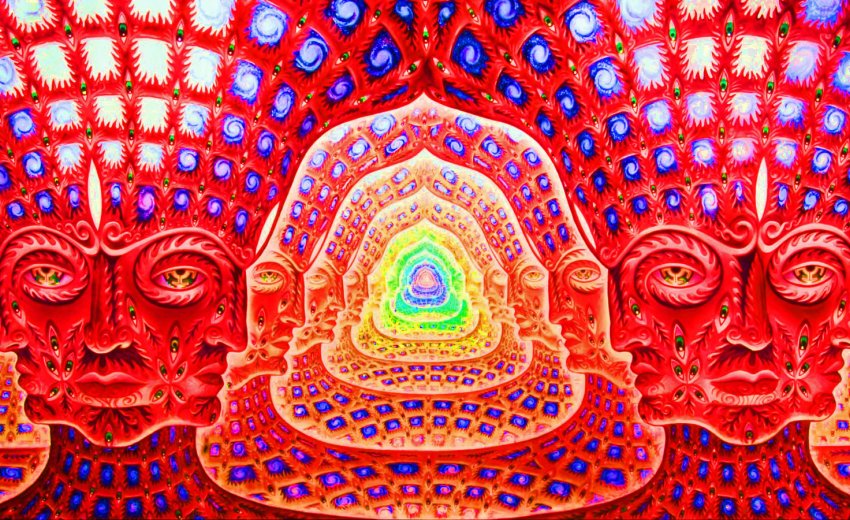Think of a universal sequence, nay, a law to human life and the word - ‘progress’ comes to mind.
Sometimes an idea sparks in a mind prepared by circumstance or conscious design, but without technology to breathe life into it, the idea remains unfulfilled. If it is not to be buried in the ash heap of history, technology must evolve to ignite it. Progress results when the idea is productively yoked to technology that provides the tools; jointly they produce application.
But the idea and the technology may not always fit each other. This may demand tweaking of the idea and/or its model. Nevertheless, fertility of the human mind is both unique and never-ending. Remember when we ‘knew’ without a doubt that a machine heavier than air would never fly. Now we know that to be nonsense.
Today, I briefly probe the religion(s) of mankind; why and how they arose and the technology that gives them life. I will largely lean on my own faith – Sikhi – but I hope that my hypotheses are pretty universal.
It is self-evident that humans at birth and in their early life are vulnerable, utterly unable to survive independently. Human survival and progress depend on viable families and communities. Shared attributes of language, culture, cuisine and music etc. provide the common ethos, and religion often becomes the binding glue that unites a people into a community.
The human comes uniquely gifted with intellect and imagination and remains largely driven by curiosity — “Who am I? Where did I come from? What is the purpose of my existence? Where was I before birth and what happens after I die? In our life and death such questions remain endlessly dissected but never fully laid to rest.
What matters most are not the questions; they may or may not always have entirely cogent answers. Important instead is that they unite a community in a shared meaning and purpose, and that makes very good glue to hold a people together. The answers may not always be verifiable or replicable, but they need be credible so that people will put their heads on the line to preserve what answers a community has evolved and accepted. Forget not that sometime the glue sets to a crazy consistency and this then hampers the ingress and egress of ideas.
Today, I offer you a kitchen sink of ideas; some underdone, others burned to a crisp, a few might even be over-spiced. It’s like a fancy dinner where everyone is salivating for the promised dessert, but we often have no idea when even the appetizer and entree might arrive.
What was India like before Sikhi emerged almost 550 years ago? For better than a millennium, India had regressed. The majority culture was Hinduism, hopelessly divided along rigidly defined, inviolate caste barriers. Low caste Hindus were no better than slaves and women lived severely restricted lives. For fuller details explore the writings of Manu, the law giver of Hindu society. Many of these features exist even today.
This internally fragmented society was easy pickings for Greeks, Arabs, Mongols, Mughals, Muslims, and a variety of Europeans. Traders, invaders and wannabe conquerors hurtled regularly into Northern India — the Punjab — to rape and pillage, conquer, perish or return with looted treasures. India at that time was a people divided into small principalities with semi-independent satraps and rulers who collaborated with invaders for petty ambitions. India was not a united nation; it’s barely that today. Hindus were and remain a monumental majority. Denied their basic rights by the politically dominant Muslims, Hindus lived under the Muslim heel with oft-enforced conversions to Islam.
In the Indian society of that time, ideas of a cooperative, multifaith, inclusive society with basic freedoms, participatory self-governance, accountability, economic progress, justice and equality at its core was a distant dream. India needed a paradigm shift. Ideals and ideas, like steps in “nation building,” can be parsed in a theoretical exercise until the cows come home; the question is: how to breathe life into them?
Thus, emerged the ideas and ideology of Sikhi along with an essential synergistic technology. Remember that without marrying the two, ideology remains hot air while technology becomes toys with no unifying larger purpose.
In the Sikh version of nation building, ideology took a couple of centuries to finally surface as the Sikh scripture – Guru Granth Sahib. Associated technology had to emerge at the same time for this sacred literature to transform a people from centuries of backward existence.
I reiterate: learning anything requires both ideas and technology, neither alone is sufficient. Think how we merge theory and practice in the making of physicians, engineers, even short-order cooks, or to impart primary school basics. There is an idea to everything good or bad, and there is a corresponding technology.
What were Guru Nanak’s first steps to forge a community?
- Teach people to interact and talk with each other.
- Shatter caste barriers by breaking bread together; these morphed into the modern Sikh langar where everyone, irrespective of gender, caste, status or religious label, would sit to share a meal – contrary to eons-old divisive practices. And thank who for this largesse? The Creator of us all who is beyond our measurements and calculations.
- Learn and participate in Naam simran, japa and kirtan.
To me, these constituted the first technological steps on the Sikh path.
Sangat and Pangat were the foundational technology for a community. Ideas and technology evolved as needed. Then were added twice a year conclaves (Sikh community and Sarbat Khalsa) for the Sikh nation. These were the beginnings of participatory self-governance.
When an armed militia became necessary for self-defense, such a force was maintained by all Gurus of the Sikh movement from Guru Hargobind to Guru Gobind Singh. The militia was substantial and powerful, but it was never directed to conquer territory, riches or people. A common language (Punjabi) and script (Gurmukhi) evolved as needed. A community’s cohesiveness demands a code of conduct, much like a Constitution, and one (Guru Granth) was pretty fully developed by the early 17th century; its formal adoption came almost a hundred years later, when rites and traditions seemed well established.
At the core was the infrastructure of Greater Punjab. Several centers and townships were founded by the Gurus, such as Kartarpur, Khadur Sahib, Goindwal, Amritsar, Tarn Taaran, Hargobindpur, Keeratpur, Anandpur, and many more in Punjab and beyond. These trading and manufacturing hubs were the infrastructure of greater Punjab. Many more examples abound, but I leave this list incomplete today; astute readers will surely add additional ideas and ideals that emerged along with technological innovations and mechanisms of support.
Today my focus is on a critical requirement in Sikhi that I have not earlier explored deeply — that of Naam. Very briefly “Naam” literally means a name, and in Sikhi it refers to the Creator. The practice of Naam then becomes remembering the Creator; its purpose becomes integrating the awareness and presence of the Creator in one’s life.
Many citations of the core ideas are possible; here I provide only two that mandate connection with the Creator by constant remembrance of him (Awar kaaj tere kitay na kaam, mil sadh sangat bhaj kewal naam, Guru Granth, Ang 12). Constantly remember the Creator, in comparison, all other activities in life are futile. I am convinced that this directive is not to be literally translated to mean that we quit our jobs and meditate on the Creator 24/7. Instead it asks that the awareness of the Creator becomes pervasive in our life, actions and words.
Intimately associated with it is our understanding of Hukum as a process of natural flow and unfolding with which we must be present with our feelings, actions and words in harmony. (Hukmae(N) undar sub ko baahar hukum na koye, Guru Granth, Ang 1). The process asks that we live entirely in the flow of the will of the Creator, accompanied by worship, praise and remembrance of the Creator. This is the usual interpretation.
If you listen to an exegesis of Sikh practice it becomes clear that remembrance of the Creator — Naam japna — is a major step. So much so that many Sikhs are proud as peacocks of how much time and effort they expend on it every day. Naam or the connection to the Creator is celebrated in Sikhi as the greatest boon that a generous Creator can bestow. Why such heavy emphasis on it? To a casual observer the practice appears as pointless repetition of hymns etc. How and why does Naam become a fundamental technology those on the path of Sikhi? A literal take on Sikhi appears to be endless praise of the Creator. Again, we need to look at this human practice more precisely. Doesn’t much, if not all of it, sound like flattery of the Creator? The Creator is an infinite reality beyond our finite human characteristics of birth and death, caste, color, creed, race, gender, and form etc., by which we document our existence. Our finite existence, language and imagination are surely not capable of capturing fully what is by definition infinite and beyond our talents and senses.
Ergo, our finite (limited) existence makes it seem necessary to recast the infinite into a finite anthropomorphic reality with which we can commune, as with any kind, forgiving human. So, looking at a human beseeching God reminds me of a massively insecure and weak human talking to the boss of his bosses – a higher, nay the highest, power, who takes great pleasure in the flattery by weaker subjects! The Creator appears to be an all-powerful reality, a micro-manager, often arbitrary, even capricious, perhaps open to a little bribery and cajolery. Basically, like a human but on a larger scale than any that we can imagine or hold. So, our relationship emerges more often from fear than love. But then why is the language of prayer cast in such humility in every religion? Clearly this is the only way we humans can transcend our endless ego when facing the endless Creator. I don’t know if God created Man in his own image but it seems that Man has created God very much in the human image, perhaps because this incarnation is easier to understand and manipulate.
Remember that our mind is obsessed with questions about what we are and why we are the way we are. Bribing or flattering the Creator should never be the answer, but it becomes so. What we humans need instead is to calm our endlessly restless mind and to be engaged with life in a productive and positive existence such that the Creator becomes the central reality of life. But we should never endow the Creator with the same weaknesses that we have discovered in our own lives. In other words, do not create a Creator in the human image.
Think back to growing up. In teaching and learning poetry, versification and music are fundamental techniques common to all mankind irrespective of their language, culture, geography, and regardless of surfeit or relative poverty of talent in the variety of people.
The ultimate purpose of religion is to impart a way of life, a philosophy to live and die for, to make a life, not a living which can and will be done in a myriad way. These are lessons for life here and now on this Earth, not necessarily for a life after death. Thus, Naam becomes a heavy-duty tried and true technology.
Look at most religions and what hits us is the repetition of the message, often as sound bites, and with minor exceptions couched in the language of music. (I understand that mainstream Islam does not easily accommodate a central place for music, but Islam has sects such as the Sufis that do. I am not certain under what circumstances the Islamic banishment of music emerged.)
There may be other minor exceptions, but I see that most religions depend on music – vocal rendition of prayers – as the fundamental process. The purpose is for the community of people to raise their voices in unison and to feel the ultimate connectivity that lies at the core of what we call “merging or being with God.” In other words, silencing the mind such that one can feel the mind at peace. As Guru Granth says: Munn pardesi je theeeyae subh des parayya (p 766.), meaning that the whole world remains alien to one who does not know his own self. Further along, “Munn jeetae jug jeet” (Guru Granth p. 1102) reminds us to conquer the mind and you will have conquered the world. Shades of Socrates exhorting us to “Know thyself?”
This simple message is designed to work a dramatic revolution in our life. What better then to cast this simple but profound message in verse. Further, frame it in the eons-old, immensely rich, classical musical tradition of India. The purpose: To seduce our ears and grab our mind to work its magic. In music humans transcend the chores and worries of life. What could be a better technique to change our consciousness? Don’t forget the ultimate purpose is to capture the mind.
Thus, there is a certain unmistakably rhythmic chanting reality to Keertan and Naam Simran – a self-hypnotic cadence and process that’s purely magical. In my view these two emerge as the most impactful and meaningful technologies to Sikh praxis. Keertan and Naam then become the defining technology of Sikhi (Kaljug mei(N) keertan pardhana, Guru Granth, p. 1075). Thoreau reminds us that “In a world of peace and love music would be the universal language.”
The practice then calms the body and mind and binds them in peace, minus the slings and arrows of outrageous fortune that visit everyday life. The goal is to be in a centered state of mind, Shunia — the zero point — the eye of the hurricane of life. Sikhs across the world, even those who do not quite understand the language of keertan or naam, feel and understand this. Hence, these two practices engage our people the most; look at any gurduara service!
How then to keep connected to this attitude and its reality? Look at humanity. Notice that most of its magical music emerges from its connection to religion. Keep in mind a little Latin “Vox populi vox dei” the voice of the people is the voice of God. Naam and Keertan capture that magic, as little else can.
An Americanism directs us to “Put our money where our mouth is.” I embrace it with a slight reframing and retranslation. Let money be your resources or efforts. The mouth of course stands for well thought ideas, like the plans of mice and men. Three things endure in my rickety life: Faith, hope and love. The greatest of the three is love.
The Founder-Gurus of Sikhi did not prescribe it but some Sikhs have added the technological discipline of physical activity as yoga and related disciplines to the practice of Sikhi. This, too, proves eminently useful for strengthening the body systems and calming the mind.
The command to meditate in Guru Granth asks us to center the mind in Naam. Focus is crucial to a meaningful life and the dedicated pursuit of any goal or activity, even if it is manufacturing widgets. The goal is a centered, focused mind that is not so easily swayed by the multitude of distractions around it and that can experience the universal connectivity that binds us all.
We all know that sometimes, engrossed in life’s trivia, the mind merges so seamlessly with whatever it is we are directing our attention towards that even the most mundane pursuit becomes sublime and effortless – pure pleasure. How then to move towards this mindset is the purpose of the daily worship that Sikhi recommends and mandates – the nitnaym.
This daily connection to the eternal within is not a bargaining chip for a life in the hereafter. It is not to guarantee a place in heaven but to help us make this life sublime.
A dear friend, Manjyot Kaur, captured the spirit of my exercise today by a witty comeback: If ideas and ideals are the compulsions of our lives, technology provides the propulsion.






